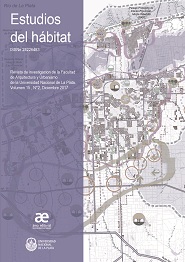Reflexiones sobre el nivel de eficiencia energética de los edificios en Argentina y su relación con las emisiones de gases de efecto invernadero
DOI:
https://doi.org/10.24215/24226483e029Palavras-chave:
Eficiencia energética, Edificios, Gases de efecto invernadero, Uso racional de energíaResumo
Uno de los aspectos de mayor relevancia en la actualidad es el cambio climático y la relación con las emisiones de gases de efecto invernadero. Diversos autores e instituciones tratan a nivel global y por países cual es la participación de los edificios, en cuanto a su construcción y mantenimiento, respecto al % en las emisiones globales. En la mayoría de los casos a partir de datos globales que proveen empresas y gobiernos de cada país. En este caso los datos surgen del que oferta un servicio energético. No es usual tener la visión, desde la demanda, a partir de trabajo de campo y auditorías en edificios. En el trabajo se exponen resultados de auditorías tendientes a trazar un perfil del nivel de eficiencia energética y emisiones GEI de edificios y viviendas en Argentina. Se debate acerca de las acciones que se han emprendido para gestionar la mitigación del impacto del sector construcciones en las emisiones GEI y el cambio climático.
Referências
ISBN 978-987-07-0603-8
Czajkowski, J. (1993). Desarrollo del programa AuditCAD para el análisis de edificios a partir de auditorías ambientales. Revista Avances en energías renovables y ambientales (3). ISSN 0329-5184.
Czajkowski, Corredera, Saposnik. (2003). Análisis de la relación entre demanda de gas natural en calefacción según “EnergoCAD” y consumos reales en viviendas unifamiliares del Gran La Plata. Revista Avances en energíasrenovables y ambiente (7). ISSN 0329-5184.
Czajkowski, J. (2015) Energy Efficiency Indicators for Buildings in Argentina. In book: The Sustainable Renovation of Buildings and Neighbourhoods. ISBN: 978-1-68108-065-9.
Discoli, Carlos (1998). El diagnóstico de la gestión productiva energético-ambiental de las redes territoriales del sector salud. Edit UNLP, La Plata.
Edwards, Brian. (2008). Guía básica de la sostenibilidad. Gustavo Gili, SL. Barcelona. ISBN 8425222087.
Filippin, C. (2005) Thermal Response of Solar and Convencional School Building to Design-and- Human Driven Factors. RenewableEnergy 30, 353-376.
González, Alejandro. (2010) Comparación de energías y gases de efecto invernadero en calentamiento de agua para cocción de alimentos con electricidad y gas natural. Avances en Energías Renovables y Medio Ambiente.
González, Alejandro; Juanicó, L y Gortari, S. (2008) High-EfficiencyPrototypes of Commercial Gas Heaters Extensively Used in Argentina. ScienceDirect. International Journal of HydrogenEnergy, 33.
INDEC (2015). Estimaciones y proyecciones de población 2010-2040. Total del país.
Downloads
Publicado
Edição
Seção
Licença
Acorde a estos términos, el material se puede compartir (copiar y redistribuir en cualquier medio o formato) y adaptar (remezclar, transformar y crear a partir del material otra obra), siempre que a) se cite la autoría y la fuente original de su publicación (revista y URL de la obra), b) no se use para fines comerciales y c) se mantengan los mismos términos de la licencia.








.jpg)

















